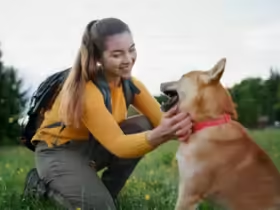Traveling with pets can be a rewarding experience, creating lasting memories and strengthening the bond between you and your furry friends. However, it also comes with challenges and responsibilities that require careful planning and consideration. In this comprehensive guide, we’ll cover essential do’s and don’ts of pet travel safety to help you prepare for a smooth journey.
Why Pet Travel Safety Matters
When traveling with pets, safety is paramount. Ensuring that your pets are secure, comfortable, and healthy during your travels minimizes stress for both you and your pets. With proper precautions, you can prevent accidents, health issues, and behavioral problems that may arise during your trip.
The Do’s of Traveling with Pets
1. Do Plan Ahead
Before embarking on your journey, research your destination and prepare accordingly.
- Check Pet Policies: Ensure your accommodation is pet-friendly and inquire about any specific rules or fees.
- Research Pet-Friendly Destinations: Look for parks, restaurants, and attractions that welcome pets.
- Visit the Vet: Schedule a pre-trip vet visit to ensure your pet is healthy and up-to-date on vaccinations. Discuss any specific travel concerns with your vet.
2. Do Use Proper Restraints
Safety during travel is crucial.
- Use a Pet Seatbelt or Harness: For car travel, secure your pet with a safety harness or seatbelt designed for pets to prevent injury in case of sudden stops.
- Travel in a Crate: If flying or if your pet is prone to anxiety, consider using a sturdy crate. Ensure it is well-ventilated and large enough for your pet to stand, turn, and lie down comfortably.
3. Do Keep Identification Updated
In case you and your pet get separated, ensure they have proper identification.
- Collar and ID Tags: Make sure your pet wears a collar with an ID tag that includes your contact information.
- Microchip Your Pet: Consider microchipping your pet for added security. This provides a permanent form of identification that can’t be removed.
4. Do Pack a Travel Kit
Prepare a travel kit to ensure you have everything you need for your pet during your trip.
- Essentials: Include food, water, bowls, leashes, waste bags, grooming supplies, and any medications.
- Comfort Items: Bring familiar items like your pet’s favorite blanket or toys to help reduce anxiety during travel.
5. Do Keep Your Pet Hydrated and Fed
Hydration and nutrition are critical during travel.
- Provide Water: Offer water breaks frequently, especially on long journeys. Portable water bowls are convenient for on-the-go hydration.
- Stick to Their Diet: Maintain your pet’s regular feeding schedule to avoid digestive upset. Bring enough of their regular food, and avoid feeding them unfamiliar foods while traveling.
6. Do Monitor Your Pet’s Behavior
Keep an eye on your pet throughout your journey.
- Watch for Signs of Stress: Signs of anxiety in pets may include excessive barking, pacing, or hiding. Be attentive to your pet’s needs and provide comfort as necessary.
- Take Breaks: For road trips, stop every few hours to let your pet stretch, relieve themselves, and explore. This will help reduce stress and anxiety.
7. Do Research Emergency Vets
Know where to find veterinary care in case of an emergency.
- Emergency Contacts: Research and save the contact information of veterinary clinics and emergency animal hospitals at your destination.
- Know Local Regulations: Be aware of pet regulations in the areas you’ll be visiting, as some places may have specific leash laws or pet policies.
The Don’ts of Traveling with Pets
1. Don’t Leave Pets Alone in a Vehicle
Never leave your pet unattended in a parked vehicle.
- Heat Stress: Cars can heat up quickly, leading to heatstroke or death within minutes, even on mild days.
- Theft Risk: Leaving pets in a car also poses a risk of theft, especially in crowded areas.
2. Don’t Use Inappropriate Restraints
Avoid using unsafe methods to secure your pet.
- No Loose Pets: Never allow your pet to ride loose in the car. This can lead to distractions while driving and serious injury to your pet in case of an accident.
- Avoid Unapproved Carriers: Don’t use makeshift carriers or non-approved restraints, as they may not provide adequate protection during travel.
3. Don’t Change Your Pet’s Diet Suddenly
Avoid sudden dietary changes during travel.
- Digestive Issues: Introducing new foods can lead to gastrointestinal upset, diarrhea, or vomiting, which can be stressful for both you and your pet.
- Stick to Familiar Foods: Always bring your pet’s regular food and treats, especially for long trips.
4. Don’t Ignore Your Pet’s Needs
Pay attention to your pet’s comfort and health.
- Watch for Signs of Illness: If your pet shows signs of distress, lethargy, or vomiting, don’t ignore it. Seek veterinary care immediately.
- Respect Their Space: If your pet seems anxious or overwhelmed, give them space and allow them to retreat to their crate or a quiet area.
5. Don’t Forget to Socialize
Socialization is key for pets, especially in new environments.
- Gradual Exposure: Introduce your pet to new experiences gradually. Allow them to explore their surroundings at their own pace.
- Supervised Interaction: When meeting other pets or people, supervise interactions to prevent any stress or aggressive behavior.
6. Don’t Assume All Destinations Are Pet-Friendly
Research the pet policies of your destinations.
- Check Before You Go: Don’t assume that all hotels, restaurants, and attractions welcome pets. Always confirm their policies in advance to avoid surprises.
- Plan for Alternatives: Have a backup plan in case you encounter a location that isn’t pet-friendly.
7. Don’t Overlook Weather Conditions
Be mindful of weather conditions when traveling with pets.
- Hot Weather: In warm weather, ensure your pet is protected from heat. Plan travel during cooler hours and ensure access to shade and water.
- Cold Weather: In cold conditions, make sure your pet is adequately protected from the elements. Small or short-haired breeds may require coats or sweaters.
Additional Tips for Safe Pet Travel
- Keep Your Pet Calm: Use calming products like pheromone sprays, anxiety wraps, or calming treats to help your pet relax during travel.
- Use a Pet Carrier for Air Travel: If flying, ensure your pet is in an airline-approved carrier that meets safety standards.
- Take Regular Breaks: For long drives, take breaks every few hours to allow your pet to stretch, hydrate, and relieve themselves.
- Secure Your Pet During Activities: If you plan on taking your pet on hikes or outdoor activities, use a leash and harness to keep them secure and safe.
Conclusion
Traveling with your pets can be a wonderful experience filled with adventure and companionship. By following these essential do’s and don’ts of pet travel safety, you can ensure a safe and enjoyable journey for both you and your furry friends. Always prioritize your pet’s well-being, and remember to plan ahead to create lasting memories together. With the right preparation, you’ll be ready to hit the road—or the skies—with confidence, knowing your pet is safe and happy.










Leave a Reply